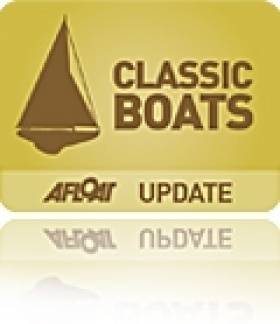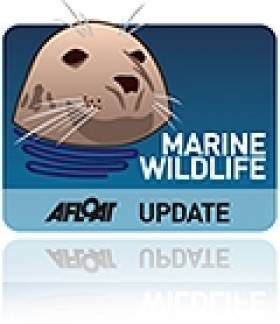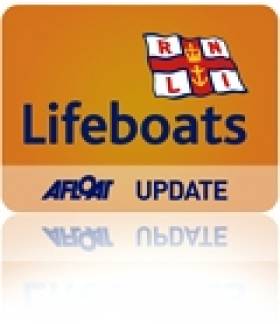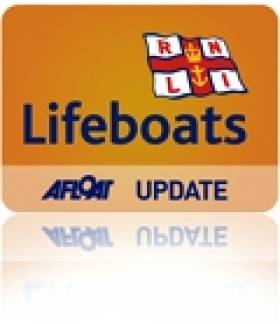Displaying items by tag: Isle of Man
ISORA Race 5 Tracker Isle of Man to Dun Laoghaire Here!
#isora – ISORA's Race five's 100–miler from the Manx port of Douglas to Dun Laoghaire starts at 0630 hours. Follow the race tracker above.
ISORA Sailors Set Sail for Isle of Man Offshore Weekend
#isora – No sooner is last night's DBSC racing over than some round–the–cans regulars are venturing outside the Bay this evening on a two–race ISORA weekend, with the Isle of Man as the focus. As David O'Brien reports in this morning's Irish Times Sailing Column the overall leader and defending champion Ruth (Liam Shanahan) has claimed a five point lead going into tonight's fourth race that has attracted a bumper fleet of over 20 that sees the focus of Irish sailing heading offshore this weekend.
The first race is tonight's 60–mile race four in the ISORA series from Holyhead in North Wales to the Isle of Man followed on Sunday by race five's 100–miler from the Manx port to Dun Laoghaire starting early at 0630 hours.
Overall, Shanahan's J109 from the National Yacht Club (NYC) leads Adrian Lee's Cookson 50 Lee Overlay Partners of the Royal St. George YC. The Pwllheli–based J109, Mojito is third. J boats occupy four of the top six places after three races and this weekend's forecast may also play into J hands.
As of this morning, the course for each race is likely to be direct from start to finish with light winds on offer and upwind a lot of upwind sailing predicted. This year's Avery–Crest sponsored series has the added attraction of satellite tracking that plots each competitors course, giving an extra dimension for race followers.
#boatswithcharacter – With the hope that boat numbers will start to increase again as we emerge from recession, categorisation resumes its central place in our thinking about the different types of craft we sail. Yet for a while, when the economy was at its nadir, you could classify your boat in almost any way you liked so long as you at least went out sailing, and kept fleet numbers at some sort of viable level.
But with things now on the move once more, some folk reckon they can afford to become a little more pernickety. For instance, the word is that the Old Gaffers Association may be going to insist that its racing awards can only be won by properly gaff-rigged boats. Yet when they were celebrating their Golden Jubilee in 2013 when the times were very thin indeed, some venerable but Bermudan-rigged craft were allowed to have a meaningful role. And if this was queried by some pedant, the official response was that they were actually setting gaff mainsails which just happened to be three-sided, and this was only as a temporary measure in response to the straitened times......
Quite so. But W M Nixon reckons that in the end, regardless of a boat's alleged type, it is character that is the final arbiter of quality both in the boats and their owners. In an exploration of this, he takes us on a virtual voyage from the Isle of Man to Achill Island, taking in some varied boat festivals on the way.
With boats as with people, it's character that counts. There are those of us who'd reckon there's more character in a battle-scarred all-plastic Cookson 50 than in a contemporary all-wood clinical re-creation of the design style of a previous era for what is known as "The Spirit of Classics" division. Though even here, the boats can begin to get some interesting character if they manage to get roughed about a bit - too much perfection is not good for the soul.
So give us a rough diamond any day, and in unusual boats, as with their owners, the waters around Ireland and nearby places have an abundance of them. One real diamond geezer is Joe Pennington from Ramsey in the Isle of Man. It always makes things that bit more right with the world when Joe comes into port with his workmanlike Manx longliner Master Frank, for Master Frank looks right, and is right – this is classic traditional, gold standard.
So it's ironic that although Joe is one of the Isle of Man's great sailing ambassadors, he's actually from north Lancashire. But he ended up working in the island as a carpenter, and failed to get off. The island, that is...As for his carpentry skills, they were up-graded to shipwright level, but he kept going as a carpenter as there was plenty of work around houses, while at same time restoring the Albert Strange yawl Emerald for his own use.
As he was based in Ramsey in the north of the island, he was very aware that it was the home port of the the last surviving Manx longliner, Master Frank built in 1895, the rapidly deteriorating example of an almost extinct species mouldering away in that very tidal harbour. People had realized the old boat's importance so much that the Manx government had been persuaded to buy her. But as with the Asgard in Ireland in the 1960s, the government may have bought her, but then they hadn't a clue what to do with her.
So one fine day, so the story goes, Joe in his working overalls marched into the Manx parliament, the House of Keys in Douglas, and berated the members for their neglect of this priceless example of the island's maritime heritage. They were flummoxed. So when he then offered to take on full responsibility for the Master Frank if they'd sell her to him with all rights for just one pound, they agreed, as enough was known about what he'd done with the Emerald to convince the assembly that this was their one last and best chance.
Restoring the Master Frank was in effect a re-build, and we have to remember that Joe was working fulltime in his day job as a carpenter. Yet he set himself a work schedule which gives you some idea of his depth of character. Many of us know Joe as a gregarious party animal. And as his appearance is something of a mixture between a gypsy king and the dangerous younger brother of a Roman Emperor, he certainly looks the part. But in order to bring the Master Frank back to life, he took the lonely route of coming home each evening after a day's work, having his tea, and then heading out that night for what was in effect another full day's work, but this time on the boat.

Most of us know Joe Pennington as a gregarious party animal, as seen here in the Peel S & CrC in the Isle of Man with Dickie Gomes of Ainmara and Stu Spence of Madcap.....Photo: W M Nixon
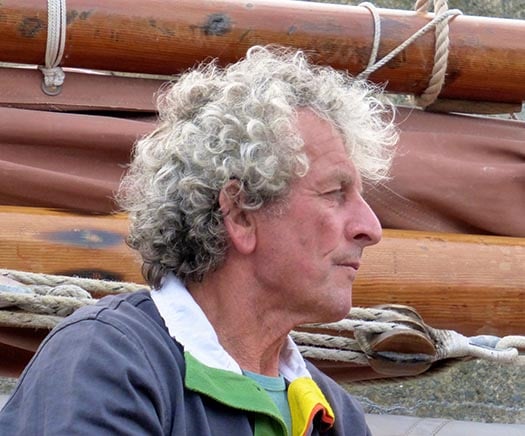
....but there's a serious and determined side to him, and he was just the man to save the very special Master Frank from extinction. Photo: W M Nixon
Night after night, week after week, the project went on, and when Master Frank was re-born, it was utterly worth the effort. Though she's only 36ft in overall hull length, she has the spirit of a much larger vessel, and her character is such that when she turns up at some assembly of classic and traditional craft, the event is a success even if only half a dozen other boats are taking part.
Just how much we'll see of her in Ireland this summer is in the lap of the Gods, as Joe likes to do a lot of cruising with his beloved boat, and Brittany calls. Master Frank is comfortable at sea, though like many workboats her actual hull freeboard is quite low – it's only the high bulwarks which seem to give her plenty of clearance.
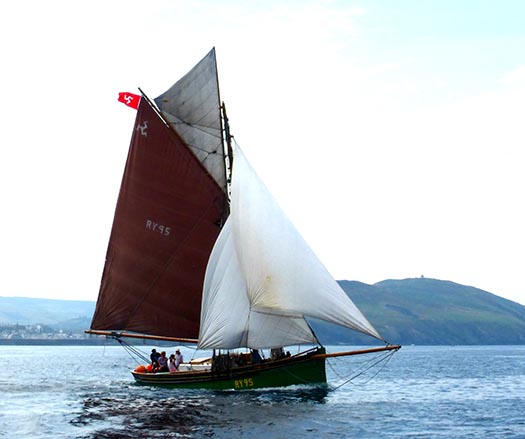
Even in this light breeze off Peel in the Isle of Man, the restored Master Frank shows her class. Photo: W M Nixon
Thus it's normal to have some water on deck when the going starts to get brisk, and this is a characteristic also seen on the famous former pilot cuter Jolie Brise. The noted photographer Brian Carlin captured this to perfection when Jolie Brise went out to the Fastnet Rock during the Glandore Classics in 2013, which happened to be the old pilot cutter's Centenary. She went round in style, but there was no lack of water on deck, and we are reminded of the designer Jack Laurent Giles' comments. After crewing offshore on Jolie Brise when he was still a trainee naval architect, his assertion was that in anything over Force 3 on Jolie Brise, you needed to wear your seaboots, but presumably you were otherwise perfectly comfortable until Force 8 or thereabouts.
 Low freeboard and heavy displacement mean water on deck, but the famous Jolie Brise is otherwise comfortable as she rounds the Fastet to celebrate her Centenary in 2013. Photo: Brian Carlin
Low freeboard and heavy displacement mean water on deck, but the famous Jolie Brise is otherwise comfortable as she rounds the Fastet to celebrate her Centenary in 2013. Photo: Brian Carlin
But while workboats like Jolie Brise and Master Frank needed low hull freeboard with high bulwarks to help them fulfill their allotted tasks, the hookers of Galway Bay were primarily people and cargo carriers, thus they have ample freeboard and are notably dry on deck. But as with the old longliner and the old pilot cutter, at crucial times in their histories the Galway Hookers have needed some determined characters working on their behalf to survive in any shape or form, and while their fleet numbers are now well up, there have been times when they seemed on the brink of extinction.
This was particularly the case in the 1960s. These days we know Dennis Aylmer of Dun Laoghaire as an ever-young senior sailor who relishes his time aboard his neat Cornish Crabber Mona. But the reality is that, more than most, Dennis has earned the right to relax with his "plastic fantastic". For in 1964 and 1965, having toured Connemara as a decidedly impecunious and very young man on his bicycle and then on a tiny motorbike searching for an authentic Galway hooker, he bought the big Morning Star at Tierna on Gorumna Island, and somehow found the resources to have her restored to basic seaworthiness, and then he brought her back to Dun Laoghaire.
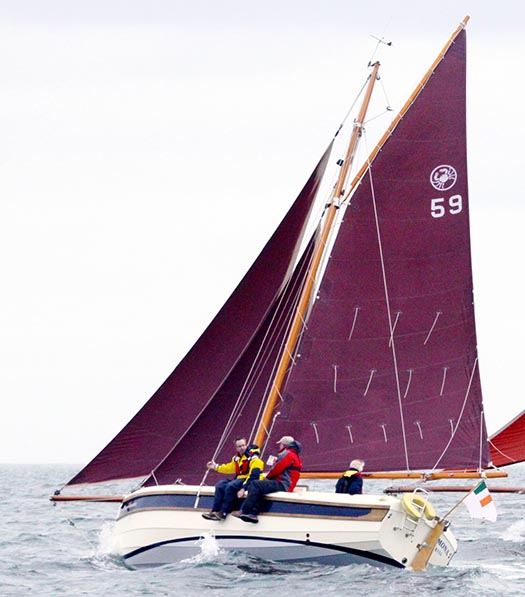
Traditional boat veteran Dennis Aylmer racing his very manageable Cornish Crabber Mona. Photo: Dave Owens
Though there were those who helped the young Aylmer in keeping the Morning Star going, in truth Dun Laoghaire in the 1960s was not a sympathetic environment for rough old gaff-rigged wooden craft. The Dublin Bay 21s had recently converted to Bermudan rig, and fibreglass was in the ascendant, with what amounted to the nucleus of a class of van de Stadt designed 36ft Excaliburs, which had a minimum of timber anywhere in their makeup.
And as work took her owner away for long periods, Morning Star's survival depended on the kindness of others. But somehow she stayed together one way or another until Johnny Healion took her over and gave her a mighty restoration for 1976 which, even on the shores of Galway Bay, was acknowledged as the initiative which led to a reversal in the decline of the old boats.
At one stage there was quite a fleet of restored Galway Hookers of all sizes in the Dublin area and along Ireland's East Coast, and they used to put in their most spectacular appearances at the Portaferry Traditional Boat Regatta in late June (this year's is 26th to 28th June 2015).
But two developments have seen the Galway Hookers' centre of gravity move very positively back to the west. The proliferation of marinas along the east coast is not bowsprit-friendly – old gaffers need a lot of pontoon length and ample manoeuvring space. And the M4 and the M6 have arrived. With Dublin coastal traffic being what it is, thanks to the motorway across Ireland to Galway, tradboat enthusiasts can get to gaffer Nirvanas like Kinvara almost as quickly as they can get to Dun Laoghaire or Howth, and they're more surely among kindred spirits when they get out west.
So although the most sacred gathering of the Galway Hookers is off Connemara at St MacDara's Island on the Saint's day, July 16th, the fleet of traditional boats around Galway Bay is really only up to full power with Cruinniu na mBad at Kinvara, which this year is August 14th to 16th.
The way that Kinvara's natural harbour is shaped, with the hospitable village and its quays at the head of a narrowing inlet which runs north and south to conveniently facilitate boats racing in the prevailing westerlies, means that this is one of the few places where sailing can comfortably become a spectator sport, and the badoiri revel in the close quarters challenges which Kinvara offers.
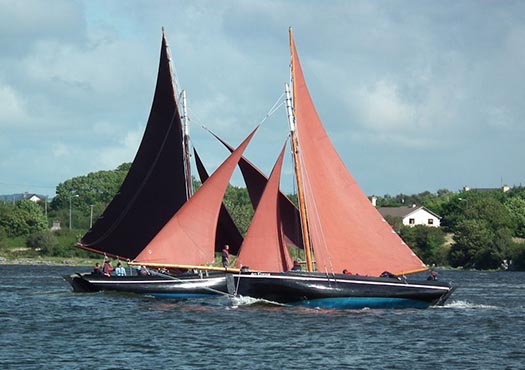
Close quarters Galway Hooker racing at its most visible – it can only be Kinvara.
However, the place becomes so crowded on the festival weekend that you might like to get your required ration of traditional boats elsewhere. But the problem is that while the sailors just want to get on with sailing among other like-minded souls on ancient craft, the organisers are usually in the numbers game, and they want to pack the pierheads and fill the vantage points with avid spectators.
It's all a long way from the long hours of solitary work which have gone into the maintenance of old boats, for which it's said the three essentials are a friend with a low-loader, a hayshed out the back of the house, and a very tolerant wife. Yet those are only the most basic requirements. When you see a gathering of traditional and classic boats in all their finery, what you're seeing is the coming together of people of real character who have had a dream, and they've stayed with it.
And if you're there at the local sea festival time, it will give you added insight into the neighbourhood. You'd be busy every summer weekend if you went with every sort of classic boat assembly, whether sailed, rowed or paddled, but if we just stick with the sailing, we find that there's a pattern which can indeed take us from the Isle of Man to Achill, and many places north and south of them as well.
They start early at Baltimore in West Cork, which could reasonably claim to be the headquarters of diversity in traditional craft, and this is celebrated from May 22nd to 24th this year with the Baltimore Wooden Boat Festival.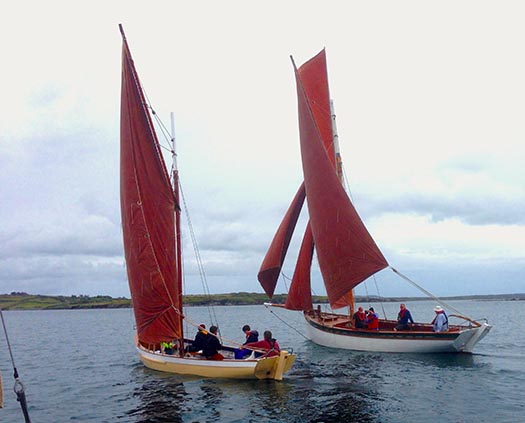
West Cork types will be much in evidence at the Baltimore Wooden Boat Festival from May 22nd to 24th. This is a classic mackerel yawl with a lobster yawl
Then the Dublin area is busy at the end of May and early June, with the DBOGA Riverfest from Poolbeg from May 30th to June 1st, while six days later, the long-established Lambay Race at Howth on June 6th now has a significant classic input with the 117-year-old jackyard topsail-setting Howth Seventeens being joined by both Old Gaffers and Classics.
Inevitably, choices have to be made as the season gains momentum, and the final weekend of June sees both the Portaferry gathering as already mentioned, and the Cobh Traditional Boat Festival on Cork Harbour from June 26th to 28th, with "traditional" naturally taken to include the 1895-vintage Fife-designed Cork Harbour One Designs.
The CHODs will also be starring in this year's main event, the Glandore Classics from July 18th to 24th. This shows every sign of being the biggest Glandore Classic Regatta ever, as the fleet will include a substantial number of Old Gaffers in the early stages of an OGA three week cruise-in-company from Kinsale to West Kerry, while the sailing will be something of a Fife Festival, as the CHODs will be sharing the same racing waters as the visiting Fife ODs from North Wales.
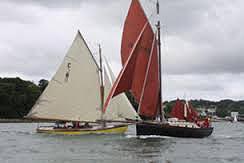
Cork Harbour One Design and Heard 28 Tir na nOg (Sean Walsh) managing to avoid each other at the Glandore Classic Regatta 2013.

Fife OD from the Menai Straits racing at Glandore Classics. Thanks to their wide side-decks, they can sail at an angle of heel unimaginable in most small keelboats, and some helmsmen reckon that the immersed lee deck provides useful lateral resistance
A notable feature of the North Wales Fifes is their wide side decks, which enable these pretty boats to heel a long way without taking water into the cockpit. In fact, it's said that some Fife helmsmen from the squally home waters of the Menai Straits reckon that if they heel their boat enough, the lee deck becomes a sort of secondary keel, and provides significant lateral resistance to enable them to continue to make to windward at an angle of heel which would have any other boat either sinking, or completely out of control, or just sliding sideways out of the picture altogether.......
Make of that what you will, but as we move on round the coast we find that currach racing becomes the dominant passion until the home waters of the Galway Hookers are reached, with the single exception of the one shining star, the Shannon Hooker Sally O'Keeffe at Kilrush, community-built at Querrin on the Loop Head Peninsula, and as sweet a little cutter as you'll see anywhere. Then on north, and we're into Galway Bay with each little port well filled with its quota of bad mor, leath bhad, gleiteog and pucaun.
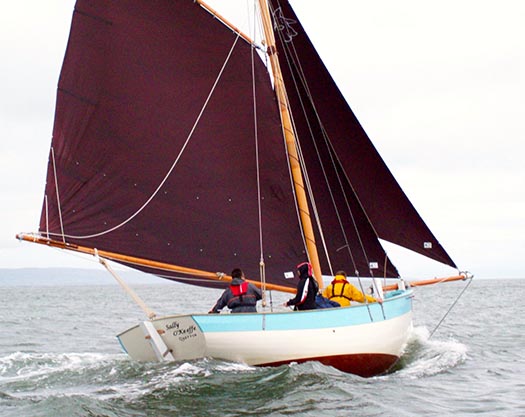
The sweetest thing in the west – the Shannon Hooker Sally O'Keeffe of Querrin on the Loop Head Peninsula
But what, you might well say, was all this about Achill Island? Well, there is a distinct species of local vessel in Achill Sound known as the Achill yawl which, with a single-sail lug rig which is almost a lateen, has a distant relationship to the classic Galway Bay pucaun.
But they have their own way of doing things in Achill Sound. At the peak of the boom years, every pub along the Sound, and local men who had done well in business abroad, between them supported a substantial fleet of Achill yawls which were raced in high summer and early Autumn with a ferocity which was astonishing even to sailmaker Des McWilliam of Crosshaven.
Heaven knows but Des has had enough experience of ferocious racing at all levels of the sport in all sorts of places. But when he went to far Mayo with a new set of threads for a keen Achill yawl owner, naturally as a diligent sailmaker he went afloat for a trial race, and came away suitably chastened by it all.
"We're just big pussy cats in Cork Harbour by comparison with Achill Sound" he reported. "In Achill racing" said he, "they take no prisoners". Yet even the hard men of Achill Sound had to ease back on their enthusiasms when the construction industry fell off a cliff. But just last September, crossing Achill Bridge, I spotted a bit of launching activity. It looks as though Achill yawl racing is showing signs of life again. But it won't be for the faint-hearted.
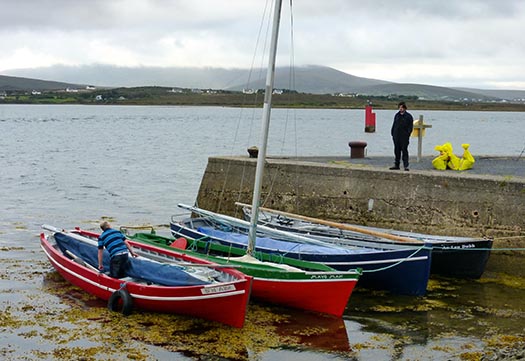
Achill yawls come in several shapes, and the most successful is not necessarily the fastest-looking. Photo: W M Nixon
World's Oldest Yacht Finally On Way For Conservation in Isle Of Man
#oldestyacht – What may well be the world's oldest yacht, the 1789-built 26ft schooner Peggy in the Isle of Man has finally been lifted out of her historic berth under Bridge House in Castletown in the isle of Man, and has been safely transferred to a specially-modified workshop in Douglas for the painstaking work of conservation to begin.
As the project with the historic Asgard by John Kearon and his team in Collins Barracks in Dublin revealed, conservation is a highly skilled job requiring much patience, and almost endless resources. But the wonderful Peggy, built 226 years ago for Manx renaissance man and pioneering yachtsman George Quayle, is very special indeed, and the people of the Isle of Man are determined to ensure that she gets the preservation treatment she deserves.
Video of the yacht being moved here
Read WM Nixon's full blog on Peggy here
Manx Seal Pup Death Rate Highest In Six Years Says Group
#MarineWildlife - Seal pup deaths around the Isle of Man are at their highest level in six years, prompting concerns for the health of the marine mammals on the Irish Sea island, as BBC News reports.
"Particularly harsh" weather conditions battering the usually sheltered islet frequented by female seals rearing pups have been blamed for the "greatest number of mortalities" since surveys began, according to the Manx Wildlife Trust.
And it's feared that the coming weeks will being more sad news for seal pups on the Calf of Man. BBC News has more on the story HERE.
Isle Of Man Lifeboat Launches To Person In Irish Sea
#RNLI - Lifeboat volunteer crewmembers with Douglas RNLI on the Isle of Man were paged at 9.24pm on Thursday evening (11 September) to a report of a person in the Irish Sea off Victoria Pier.
The all-weather lifeboat Sir William Hillary was launched under the command of coxswain Neal Corran, who proceeded to the seaward side of the Victoria Pier where the person was successfully located.
The casualty was recovered to the lifeboat and taken immediately to the Liner Berth inside the harbour to a waiting ambulance.
The lifeboat then returned to the boathouse to be washed down, re-fuelled and was ready again for service at 10.15pm.
#ISORA – The Offshore Racing Weekend, a higlhight of the 2014 ISORA calendar, started with a fast and furious 'midnight' race from Liverpool to Douglas with a fantastic spinnaker leg for the entire 75 mile voyage. Results are available to download below. The first boat in was Jackknife who finished approximately 0200hrs on Saturday morning followed rapidly by the rest of the fleet and the last boat finishing approximately 0630hrs.
Bada Bing (Andy Napper, Andy and Annie Farrell) were overall winners again this year. Baba Bing, a Humphreys 30, was previously known as Men Behaving Badly, and subsequently Hot Rats and was built at Firmhelm in Pwllheli.
#isora – ISORA sailors are in bullish form after a strong turnout last night for the 97th race from Liverpool to Douglas in the Isle of Man. Organisers of the Offshore Racing Weekend are hoping hoping that the 25–boat fleet for the first race to Douglas will increase for the Douglas to Dún Laoghaire race tomorrow, Sunday.
The 75–mile race started last night at 18.30 and is sailed under the burgees of Tranmere Sailing Club and Liverpool Yacht Club.
The second offshore race starts on Sunday morning at 0900hrs from Douglas to Dun Lagohaire, a distance of approximately 80 miles.
The offshore weekend is a new Irish Sea initiative bringing together boats from across Northern Ireland, the Isle of Man, England, Wales and Ireland. The venture has won the support of Hudson Wight who are providing prizes for the weekend offshore series.
This race is also a feeder race for the ICRA championships in Dun Lagohaire next weekend.
Traditional Boats of Peel, Isle of Man Do The Business
The Peel Traditional Boat Weekend at the hospitable port on the west coast of the Isle of Man has been developing steadily since its inception in 1991. Located in the middle of the Irish Sea, the Peel gathering has become a magnet for boat enthusiasts of all kinds from Ireland, Wales, England and Scotland. W M Nixon sampled it for the first time in August 2013, and found that it deserves its hospitable reputation.
#peel – Cruising around the Isle of Man is dictated by its extraordinary tides. We may not be talking of the exceptional ranges of the Bay of Fundy, but you're right up with the North Coast of Brittany in the island's huge rise and fall. As for the ports, there are only two which have been fitted with automatic gate flaps that retain enough water in their harbours for civilised berthing at marina pontoons when the tide has receded.
These are the island's capital of Douglas on the east coast, and the ancient fishing stronghold of Peel on the west. At other ports such as Ramsey, Laxey and Castletown, you have to be prepared to dry out alongside. There are anchorages of sorts available at the main sailing centre of Port St Mary on the south coast (where it is also possible to lie afloat alongside at low water, but it's an unbelievably long way down), at Derbyhaven in behind the island's southeast corner of Langness, and at Port Erin towards the southwest corner, but they don't really provide the restful berths which cruising folk hope to find at the end of a day's sail.
We'd hoped to round out our two year sailing celebration of the centenary of Dickie Gomes' 36ft yawl J B Kearney Ainmara by an easygoing circuit cruise of the Isle of Man (the old girl won the Round Isle of Man Race in 1964, when she was but a stripling of fifty-two summers), and conclude it with participation in the Peel Traditional Boat Weekend 2013, in its turn the concluding event in the Irish Sea of the Golden Jubilee celebrations of the Old Gaffers Association, in which we'd already been much involved in Dublin and Belfast. But it was a programme which just couldn't be made to integrate.

While the Isle of Man would be attractive to cruise round if the harbours at Ramsey, Castletown and Port St Mary provided floating berths, the fact that only Peel and Douglas have marinas enclosed within gate flaps makes it very tempting to keep your boat at one of these two ports, and see the rest of the island by other means.
Though I haven't seen it stated in any relevant cruising directions (perhaps because it's so bleeding obvious), the sensible time for a three or four day cruise around the Isle of Man is when high water is morning and evening. That means you can arrive off your chosen port for the night at a civilised hour, and go in immediately. Even if you've had to dry out overnight, you can still depart at your leisure in the morning on the new tide, and though you may have to push tidal streams to the next port, the tides are much smaller when high water is morning and evening rather than noon and midnight, so you have a chance of overcoming any adverse streams. Then too, the weaker tide means there's less likelihood of rough water, which in certain areas of the Isle of Man is something of a speciality.
But the format of the Peel Traditional Boat Weekend scuppered this fine plan of a leisurely island circuit. The Weekend is staged when high water is pushing towards lunchtime, as the waterborne highlights of what is really a five day boatfest are Parades of Sail on the Friday and the Sunday. On those days, everyone is expected to head seawards just as soon as the automatic gate flap goes down, then they tear around on the Irish Sea for a couple of hours with all sail set, showing off big time, and then they scuttle back into port before the gate comes up again.
It works very well, but it means that you're totally Peel-focused for the berthing of your boat while the festival is in full swing. So we reckoned the only solution was to give in gracefully. Ainmara secured a marina berth handily off the Creek Inn, and there we were every night from Wednesday August 7th until Sunday August 11th, absorbing Manx culture by the bucket-load, and taking on board nautical ideas, rig designs, and boat layouts of every imaginable type, plus a few totally unimaginable as well.

Ainmara manoeuvring into her convenient berth in Peel Marina off the Creek Inn. Photo: W M Nixon
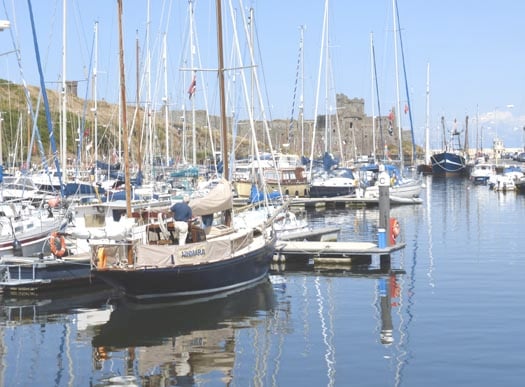
High summer in the Isle of Man. Looking seaward down the inner harbour at Peel towards the castle. Photo: W M Nixon
It was the ideal scenario for a plague-like outbreak of harbour rot, but as already reported here on August 24th, we made an immediate point of visiting the world's oldest yacht, at her abode in the characterful old port of Castletown before contemplating anything else. And then between the jig and the reels we saw a lot of this fascinating island by many different means of transport, only drawing the line at the ancient tram which runs between Douglas and Ramsey, because even for the most easy-going cruising man, it is just too slow.
Perhaps it's there to offset a central part of Manx culture, the TT motorcycle jamboree. The tram may well be a deliberate reminder of the slow and safe life, but the TT is all about fast and dangerous, and it's almost a religious cult. With the quaint little winding roads, the Isle of Man is probably the only place in the world where the tourism authorities will object if the road engineers want to straighten out a particularly dangerous corner.
One of our ship's complement of three, Brian Law, is a mad keen biker, so he really was in seventh heaven, but we kept him grounded with more sedate ways of travel such as the little old very smoky narrow gauge steam railway which runs from Douglas eventually to Port Erin - and don't forget to start your journey with the fireman's breakfast off a shovel in Douglas station.
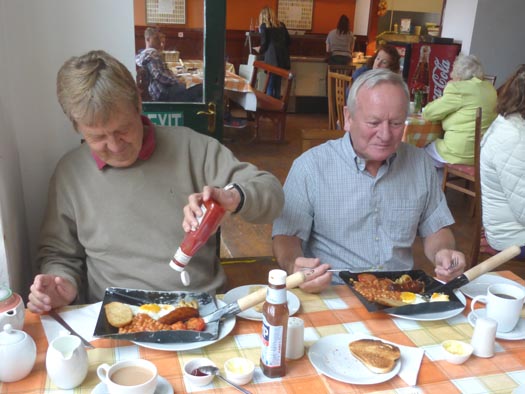
The only way to start the journey – the Fireman's Breakfast in Douglas Station, served on a shovel. Photo: W M Nixon
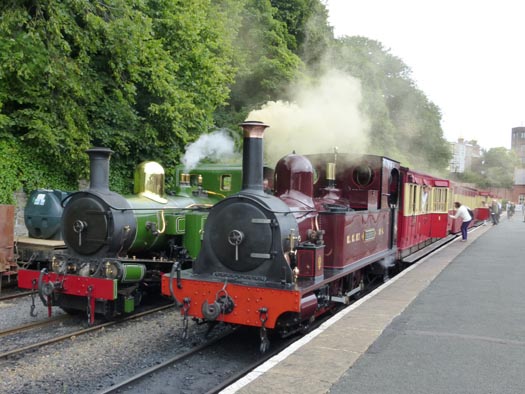
The Peel to Port Erin Express. Needless to say, each vintage compartment had a No Smoking sign. Photo: W M Nixon
But having done the island from end to end, the crew of Ainmara would like it to be known that the best way to cruise the Isle of Man is up front on top of a double-decker bus. Much of the island scenery is a sort of miniaturised Ireland or Scotland, so at first it seems completely bizarre that urban double-deckers run on many of the routes. And up top, it has to be admitted that at times the old bus gets a mighty wallop from a tree branch. But the views are marvellous, you get to meet a fascinating array of the locals, the bus will take you scenically to an extraordinary variety of towns and villages, and at day's end you return to Peel, the most characterful place of all, and there sits your boat serenely off the inn, and the party just getting going. It's cruising perfection.
And for anyone into traditional or classic or just interesting boats, Peel is paradise. We'd got the flavour of it as we'd arrived in the sunshine of a perfect summer's day on the Wednesday, going through the narrow entrance with Mike Clark's Manx nobby White Heather – traditionally rigged with huge lug mainsail – to starboard, while to port beside the harbour office was the superbly restored varnished Ray Hunt-designed 57ft Drumbeat, originally built for Max Aitken with twin centreboards – one for each tack – back in 1957, and newly arrived as an Isle of Man resident after her second total restoration.

Mike Clark's restored Manx nobby White Heather sets the classic lug rig.

The superstar of 1957. The restored Drumbeat with her varnished hull is a new resident of the Isle of Man. This view is looking seaward towards the Outer Breakwater over the footbridge and gate flap at the entrance to Peel Inner Harbour with its marina. Photo: W M Nixon

Peel's marina has revitalised this former fishing port. Photo: W M Nixon
Peel has always had something special, and since it got its gate flap in 2005 and the 124-berth marina three years later, the harbour area has been on the up and up, and the maritime community spirit in the town is a real tonic. We got our first taste of it that night in the Peel Sailing and Cruising Club where there was a merry buzz and a sense of anticipation with greetings for many old friends already there, and more on the way with the clubhouse affording a fine view of the outer breakwater, above which the upper rigs of gaffers could be seen as they headed for port in the last of the evening light, providing an entertaining guessing game as to which boat would be revealed as they swept past the outer end.
In the morning the harbour was sunlit and lively with more boats which had come in on the midnight tide. We finalised our entry and found that as were to do our duty by making a holy show of ourselves during the Parades of Sail for the delectation of the public, our hosts in turn would feed and water us in port, with the makings of breakfast put aboard each morning, and a fine feed for all crews each night in the Masonic Hall, the only place in Peel big enough to cater for the crowd.
All this hospitality at the Peel Traditional Boat Weekend involved many people and several organizations with a raft of sponsors, so it was a bit difficult to keep track, but as the two days of sport afloat had their timing dictated by the opening of the gate-flap, it was literally a case of going with the flow and enjoying yourself.
The basics of the weekend's administration were provided by Mike Clark of the traditional Manx Nobby White Heather and his PL 2013 team, but while they with their access to the Masonic Hall had the space for the crowd scenes, Andy Hall the Commodore of Peel S & Cr C and his many volunteers provided an additional key focal point in their fine clubhouse. So we'd all these delightful folk making a massive and very effective voluntary input to our enjoyment, and that was before we acknowledged the contribution of the top honchos of the various Old Gaffer Associations from all round the Irish Sea.

Mike Clark of White Heather heads up a remarkable squad of volunteers to make the Peel Festival a success. Photo: W M Nixon
Peel is a natural centre to draw in boats from Scotland, Ireland north and south, North Wales, and northwest England, so much so we had to stop ourselves thinking it was like a conference of Sub-Saharan African states, as the gathering was eventually to include Their Excellencies the Presidents or Senior Plenipotentiaries of Nioga, Dboga, Nwoga and Soga. More boats came in on every tide with more than 70 finally in the fleet, and as they wouldn't be able to get out across the gate-flap until late morning next day (Friday August 9th) for the first Parade of Sail, there was ample time in the sunshine to inspect the gathering in its glorious variety.
Stu Spence's 1875-vintage Pilot Cutter Madcap from Strangford Lough was in, recently back the Isles of Scilly where they'd renewed the rudder stock after breaking it west of Brittany, and steering themselves unaided by the cunning use of trailed buckets all the way to Scilly, where with considerable ingenuity they fixed the rudder. The crew for this remarkable feat included noted Isle of Man sailor Joe Pennington whose own restored Manx longliner Master Frank was another of the stars of Peel.
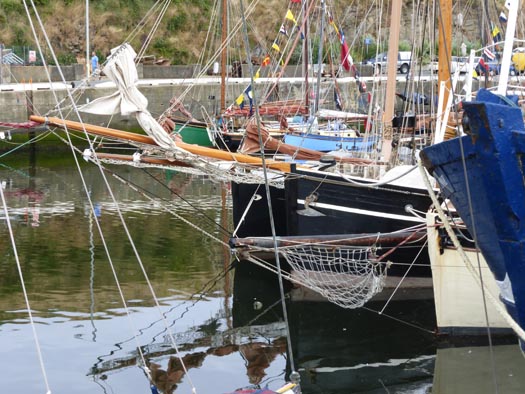
"Dock probes". Bowsprits were everywhere – these are on Mona, Vilma and (foreground) Madcap Photo: W M Nixon
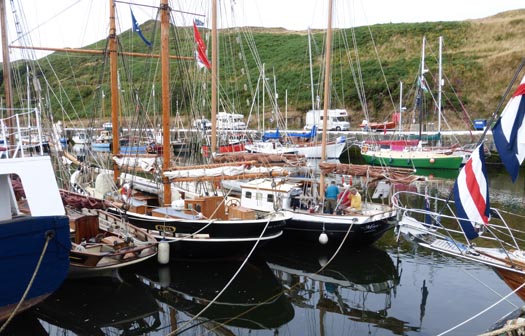
The sterns came in all shapes and sizes – these are (left to right) Madcap, Vilma and Mona Photo: W M Nixon
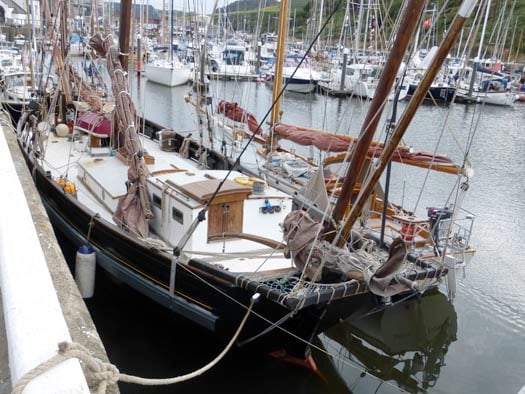
The Bisquine-rigged Peel Castle from West Cork, and outside her the Warington-Smyth cutter Dreva from North Wales. Photo: W M Nixon

We still await a photo which does justice to the West Cork-based Bisquine-rigged Peel Castle under sail (it would need to be in a lot of wind). Meanwhile, this one of her setting up her spars gives some idea of the eccentric rig which Graham Bailey has installed. Photo: W M Nixon
Ingenuity on a massive scale had also been involved in the creation of Graham Bailey's lugger Peel Castle from West Cork, which despite her name was originally a 50ft Penzance fishing boat built in Cornwall in 1929, but had been so named because Peel Castle was a familiar landmark for the roving Penzance fleet, and it is also the title of a much-loved fishermen's hymn. Though built as a motorized vessel, this fine vessel effectively had a sailing hull, thus when Graham bought her in 1999 he was acquiring a traditional sailing hull just as new as he could get. He spent nine years restoring and converting her at Oldcourt on the Ilen River, rigging her as an eye-catching French bisquine. With three masts in a fan configuration, she certainly looks unusual, but her sailing record speaks for itself, as she has cruised the length of the Mediterranean to Greece, and was in Peel in the latter stages of a three-month round Ireland cruise with extras which had already included a detailed cruise of the Hebrides and a passage out to St Kilda.
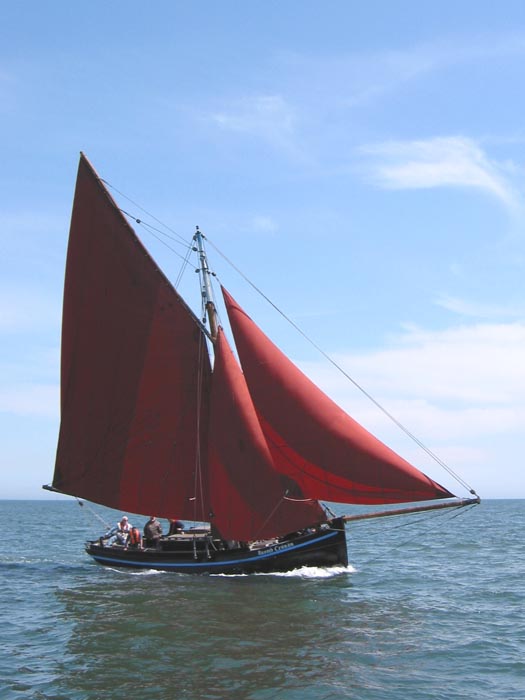
The Galway Hooker Naomh Cronan was built in Clondalkin, West Dublin, by a co-operative which still functions successfully after 15 years. Photo: W M Nixon

The Albert Strange yawl Emerald sailed south by Scottish owner Roger Clark was one of many smaller craft taking part in Peel 2013. Photo: Carol Laird
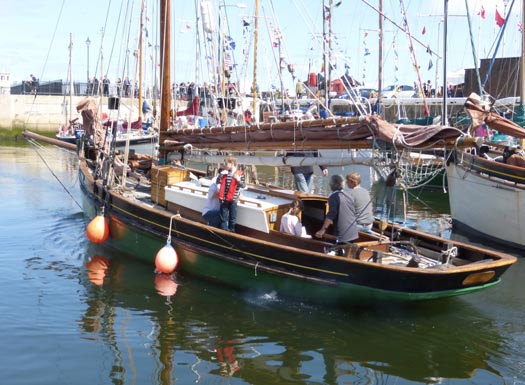
Joe Pennington's Manx longliner Master Frank is the sole survivor of a once numerous Ramsey-based sailing fishing fleet. Photo: W M Nixon
Irish traditional boats were flagshipped by the big Galway Hooker Naomh Cronan, which has been built and kept going for a remarkable 15 years by a co-operative based in Clondalkin in West Dublin, while the long story of Welsh slate schooners was represented by Scott Metcalfe's Vilma from the Menai Straits. She may have started life in 1934 as a ketch-rigged Danish sailing fishing boat, but when Scott and his wife Ruth restored the hull at their boatyard in Port Penrhyn on the Straits, they fitted her with a classic Welsh schooner rig, with the square sails aloft on the foremast mainly handled from deck. The hull certainly shows Vilma's Baltic origins but her rig, as we were to see when the Parade got going, is very much Welsh schooner, and apparently easy to handle, though that may have been the skill of the crew.

Vilma was one of the stars of the show. Photo: Carol Laird
Finally the gate-flap opened later than expected on the Friday morning, and those who were up for the Parade – not everyone by any means – went out onto a lively sea with the sun coming and going and a good breeze sweeping in from the west. Provided we didn't have to go to windward, Ainmara could carry full main, and so long as we kept reaching, she could carry jib tops'l too. So with Brian on the helm, she reached up and down in all her finery, and though we had to throw the outer tack a couple of miles out in a rumbly seaway each time we shaped up to parade back towards Peel, when nearing the shore on the inward track we asked our helmsman to tack as far up the outer harbour as he could at the inner turn in order to provide the smoothest possible water for elderly gentlemen hopping about the deck to clear sheets.

Zapping along – Ainmara at full speed as she shapes her course in towards Peel Castle and the circuit of the Outer Harbour. Photo: W M Nixon
Being a biker, Brian is an ace close quarters helmsman, and each time coming in he brought Ainmara right into the upper reaches of the outer harbour as though he expected to go straight on up the main street. Then a long elegant curving tack, and out we went again with everything setting to perfection before open water was reached, and the old girl outsailing everything else large and small, all great fun.
We'd more of the hospitality that evening with a substantial supper in the Masonic Hall and a great session in the sailing club with Adrian Spence and Joe Pennington in fine form as they detailed their experiences in getting the rudderless Madcap in to Hughtown from somewhere off Ushant, and then a blow-by-blow account of the re-installation of the re-built rudder.
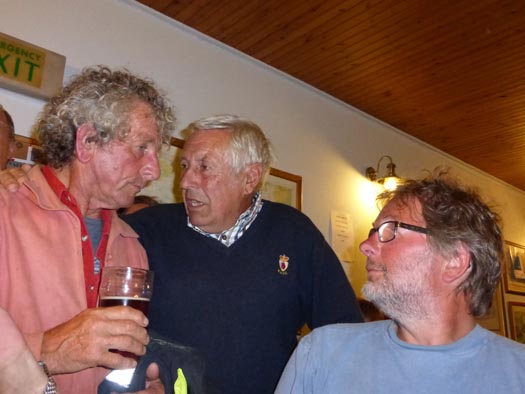
Everybody has a right to their opinion....Joe Pennington, Dickie Gomes and Adrian "Stu" Spence in conference in Peel S & Cr C. Photo: W M Nixon
The Peel people were as good as their word in putting the makings of breakfast on board each morning, but they had started gently enough with standard bacon and egg and the usual extras on the Friday. Then Saturday started the grown-up breakfasts, with a bag of magnificent Manx kippers placed into the cockpit. Our captain became the kipper skipper. We were pleasantly surprised at how much of a dab hand our master and commander was in cooking them lightly to perfection, and by the time we got back from the island, it was difficult to imagine starting the day any other way.
That Saturday (August 10th) was a sort of public interaction day, and included a "dirty boatbuilding" competition beside the harbour, with each team being given enough material to build a small boat – well, not so much a boat, more something that would just about float - then they were given a time limit to finish. The whistle blew to start, it blew again to signal time up, and the winners were the first team whose crewed boat managed to get across the harbour. They had all the teams they needed, though few enough old gaffer owners took part, as they reckoned most of their winters were spent like this, and they'd prefer to do just about anything else, while for Ainmara's crew, it was the day of the great steam train ride.
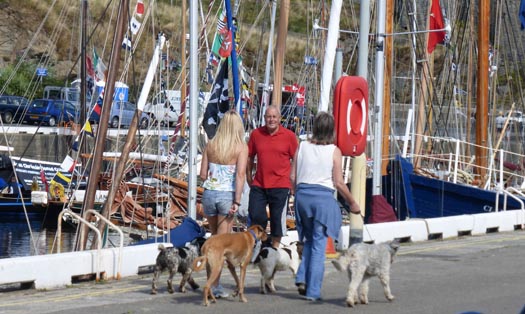
It may be the Peel Traditional Boat Weekend, but walkies are still expected. Photo: W M Nixon
Back in Peel for the Saturday night festivities, Andy Hall, Commodore of the Peel S & Cr C (which is twinned with Down Cr C) had told us not to eat ourselves silly early on, as the real feasting would take place in his club from 9.0 pm onwards. It was a masterwork of voluntary enthusiasm. His members threw themselves into preparing a mountain of queenies (the succulent Manx queen scallops) cooked six different ways, and a very eclectic clientele (for this seems to be one of the highlights of the Manx social calendar) threw themselves into a massive over-consumption in which all pretences at dining delicacy went by the board. We ate ourselves to a standstill with strangers now the best of friends, but it wasn't an exceedingly late night, for with a week's supply of protein taken aboard in one go, we'd to go back to the boat at a reasonably early hour to sleep it off.
It must have all been cooked to perfection, for there were no ill effects in the morning (Sunday August 11th) and we could breakfast off the skipper's kippers with relish. But while our guts were well settled, the weather was anything but. Though a passage home was a possible if rugged proposition for that Sunday with a fresh to strong sou'wester expected, strong west to nor'wester forecast for the Monday would have meant a dead beat, and no go at all for ancient craft.
We were all three on a three-line whip to be back by Monday night. So instead of taking part in Sunday's Parade of Sail, Ainmara returned across the Irish Sea while we could. Even if it did involve a demanding slug of a passage, it was a shrewd move, for anyone from the east cost of Ireland who stayed until Monday didn't get back until Tuesday.
It was a couple of weeks before news of the awards filtered through. Not surprisingly, both Vilma and Peel Castle received major trophies. But as we'd been a no show in the second Parade of Sail, it was a complete surprise that Ainmara had been awarded the Creek Inn Trophy for Best in Show for her one appearance on the Friday. It was the jib tops'l wot done it. All credit to Mike Sanderson of Sketrick Sails for making the old girl a very elegant set of threads. It was a sweet ending to two seasons of centenary celebration.
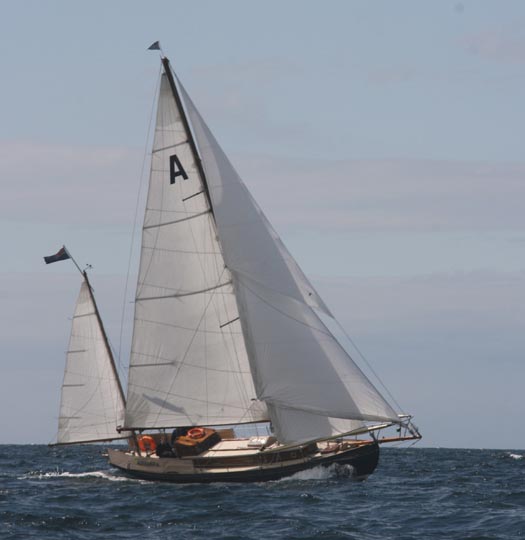
"It was the jib tops'l wot done it......" Ainmara in fine form, on her way to winning the Creek Inn Trophy for 'Best in Show'. Photo: Carol Laird
Isle of Man Lifeboat Launches To Stranded Kayakers
#RNLI - Douglas RNLI lifeboat on the Isle of Man was launched last night (4 September) at the request of Douglas Coastguard following the report of two kayakers stranded on the seaward side of Douglas Breakwater.
The RNLI all-weather lifeboat Sir William Hillary was launched under the command of volunteer deputy second coxswain Graeme Cushnie, to assist the coastguards by illuminating the scene from seaward, allowing coastguard rescue officers to negotiate their way down the sea defence wall and bring the kayakers to safety.
Both kayakers having been reported as safe and well the lifeboat was able to recover both kayaks from the Irish Sea to the visitors’ pontoon at the Battery Pier.

